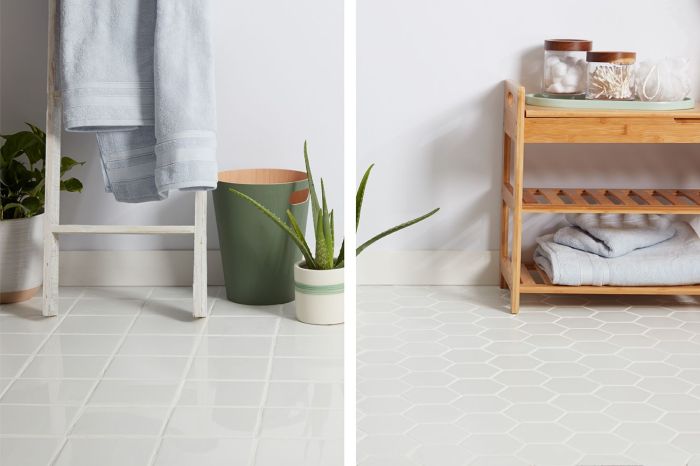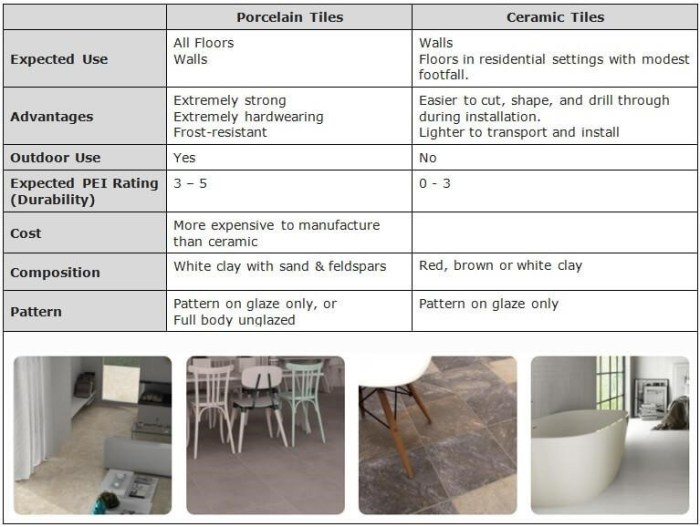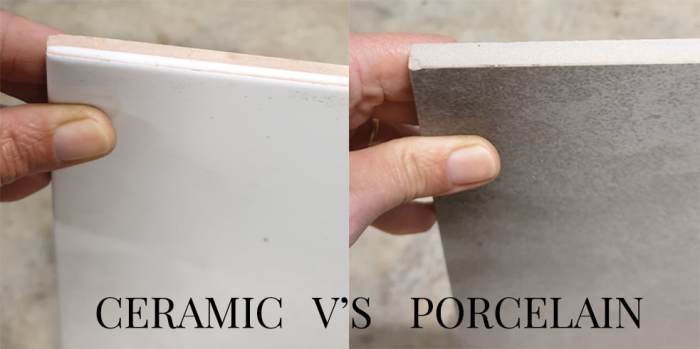When it comes to bathroom remodeling, the choice of tiles can make a significant impact on the overall design and functionality of the space. Ceramic and porcelain tiles are two popular options that offer distinct advantages and considerations. This comprehensive comparison will delve into the material composition, design possibilities, installation and maintenance requirements, cost and value, and environmental implications of both ceramic and porcelain tiles, providing you with the insights necessary to make an informed decision for your bathroom renovation.
Whether you’re seeking classic elegance or modern flair, ceramic and porcelain tiles offer a wide range of aesthetic options. From vibrant colors to intricate patterns, the design possibilities are endless. Understanding the unique characteristics of each tile type will empower you to create a bathroom that reflects your personal style and meets your practical needs.
Material Composition and Characteristics
Ceramic and porcelain tiles, commonly used in bathrooms, exhibit distinct differences in their composition and properties. Understanding these differences is crucial for selecting the most suitable tiles for your bathroom’s specific requirements.
Ceramic tiles are primarily composed of clay, feldspar, and other minerals. The clay undergoes a firing process at high temperatures, resulting in a hard and durable material. Porcelain tiles, on the other hand, are made from a finer, more refined clay that is fired at even higher temperatures.
This process yields a denser and more impervious material compared to ceramic tiles.
Durability
The higher firing temperature of porcelain tiles makes them denser and more durable than ceramic tiles. Porcelain tiles have a higher Mohs hardness rating, indicating their resistance to scratching and wear. They are well-suited for high-traffic areas, such as bathroom floors, where durability is essential.
Water Absorption
Water absorption is a critical factor in bathroom tiles. Porcelain tiles have a significantly lower water absorption rate than ceramic tiles due to their denser composition. This makes porcelain tiles less susceptible to water damage, staining, and the growth of mold and mildew, making them an ideal choice for areas exposed to moisture.
Stain Resistance
The dense structure of porcelain tiles also contributes to their superior stain resistance compared to ceramic tiles. Porcelain tiles are less likely to absorb stains from spills or cleaning products, making them easier to maintain and keep looking fresh.
Examples of Materials
Examples of specific materials used in ceramic tiles include red clay, white clay, and stoneware. Porcelain tiles are typically made from kaolin clay, which is known for its purity and whiteness.
Design and Aesthetics
Ceramic and porcelain tiles offer a wide range of design possibilities to enhance the aesthetics of your bathroom. They come in a diverse array of colors, textures, and patterns, allowing you to customize the space to your unique style.
Ceramic tiles are available in a vast spectrum of colors, from classic white and black to vibrant hues like emerald green and sapphire blue. They also feature various textures, such as glossy, matte, and textured, adding depth and dimension to the walls and floors.
Additionally, ceramic tiles come in a multitude of patterns, including geometric designs, floral motifs, and intricate mosaics, providing endless opportunities for creative expression.
Variations in Porcelain Tiles
Porcelain tiles, known for their exceptional durability, also offer a rich selection of design options. They come in a variety of colors, including neutral shades like beige and gray, as well as bolder colors like navy and burgundy. Porcelain tiles are available in both glossy and matte finishes, creating different visual effects.
Furthermore, they come in various sizes, from small mosaics to large format tiles, allowing for versatile design possibilities.
Popular Design Styles
Both ceramic and porcelain tiles can be used to create popular design styles for bathrooms. For a classic and timeless look, consider using white subway tiles or marble-look tiles. For a modern and sophisticated ambiance, opt for large format tiles in neutral colors or tiles with geometric patterns.
If you prefer a rustic or farmhouse style, choose ceramic tiles with a textured or distressed finish.
Installation and Maintenance
The installation process for both ceramic and porcelain tiles is similar, but there are a few key differences. Ceramic tiles are typically thinner and more flexible than porcelain tiles, making them easier to cut and install. Porcelain tiles, on the other hand, are more durable and less likely to chip or crack during installation.
Once the tiles are installed, they must be grouted. Grout is a thin, cement-based material that is used to fill the gaps between the tiles. Grout helps to protect the tiles from moisture and dirt, and it can also be used to create a decorative effect.
Maintenance
Ceramic and porcelain tiles are both relatively easy to maintain. They can be cleaned with a mild detergent and water, and they do not require any special sealing or waxing.
However, there are a few things you can do to help ensure the longevity of your tiles:
- Avoid using harsh chemicals or abrasive cleaners on your tiles.
- Clean your tiles regularly to remove dirt and grime.
- Seal your tiles if they are in a high-traffic area or if they are exposed to moisture.
Cost and Value
When selecting tiles for your bathroom, cost and value are important considerations. Ceramic tiles are generally more affordable than porcelain tiles, both in terms of material and installation costs. However, porcelain tiles offer greater durability and aesthetic appeal, which may justify their higher price tag.
Material Costs
Ceramic tiles are made from a mixture of clay and other natural materials, while porcelain tiles are made from a finer clay that is fired at a higher temperature. This difference in composition results in porcelain tiles being more dense and less porous than ceramic tiles.
As a result, porcelain tiles are more resistant to moisture, stains, and wear, making them a more durable choice for bathroom applications.
Installation Costs
The installation cost of ceramic and porcelain tiles is similar, with both types of tiles requiring a skilled installer to ensure a proper fit. However, porcelain tiles may require a slightly more specialized installer due to their higher density and hardness.
Maintenance Costs
Ceramic and porcelain tiles are both relatively easy to maintain, requiring only regular cleaning with a mild detergent. However, porcelain tiles are more resistant to stains and scratches, which may reduce the need for frequent cleaning and maintenance over time.
Value Proposition
Ultimately, the choice between ceramic and porcelain tiles depends on your specific needs and budget. If you are looking for a more affordable option that still offers good durability and aesthetics, ceramic tiles may be a suitable choice. However, if you are willing to invest in a more durable and aesthetically pleasing tile that will require less maintenance over time, porcelain tiles may be a better value proposition.
Examples
For example, if you are renovating a small bathroom on a tight budget, ceramic tiles may be a more cost-effective option. However, if you are designing a large master bathroom and want a tile that will withstand heavy use and look beautiful for years to come, porcelain tiles may be a better choice despite the higher upfront cost.
Environmental Considerations
Ceramic and porcelain tile production both have environmental implications, but porcelain tiles generally have a higher impact due to the higher firing temperatures and energy consumption required.
Raw Material Extraction
Ceramic tiles are made from clay, while porcelain tiles are made from a combination of clay, feldspar, and quartz. The extraction of these raw materials can disrupt ecosystems and contribute to deforestation. Porcelain tiles require more raw materials and energy to produce than ceramic tiles, as the higher firing temperatures necessitate more fuel consumption.
Energy Consumption
The firing process for porcelain tiles consumes significantly more energy than that for ceramic tiles. The higher temperatures required for porcelain tiles result in increased greenhouse gas emissions. Additionally, the glazing process for porcelain tiles often involves the use of toxic chemicals that can pollute the environment.
Waste Generation
Both ceramic and porcelain tile production generate waste, including scrap tiles, dust, and glaze waste. However, porcelain tiles typically generate more waste due to the higher firing temperatures and the use of additional raw materials.
Eco-Friendly Practices
To reduce their environmental impact, manufacturers of both ceramic and porcelain tiles are adopting eco-friendly practices. These include:
- Using recycled materials in tile production
- Reducing energy consumption through the use of energy-efficient kilns
- Investing in renewable energy sources
- Implementing waste reduction programs
By choosing tiles from manufacturers that prioritize sustainability, consumers can help reduce the environmental impact of their bathroom renovations.
Outcome Summary
In conclusion, both ceramic and porcelain tiles present compelling options for bathroom flooring and wall coverings. Ceramic tiles offer affordability, versatility, and ease of maintenance, while porcelain tiles excel in durability, water resistance, and design flexibility. The choice between the two ultimately depends on your individual preferences, budget, and the specific requirements of your bathroom.
By carefully considering the factors discussed in this comparison, you can make an informed decision that will enhance the beauty, functionality, and value of your bathroom for years to come.



